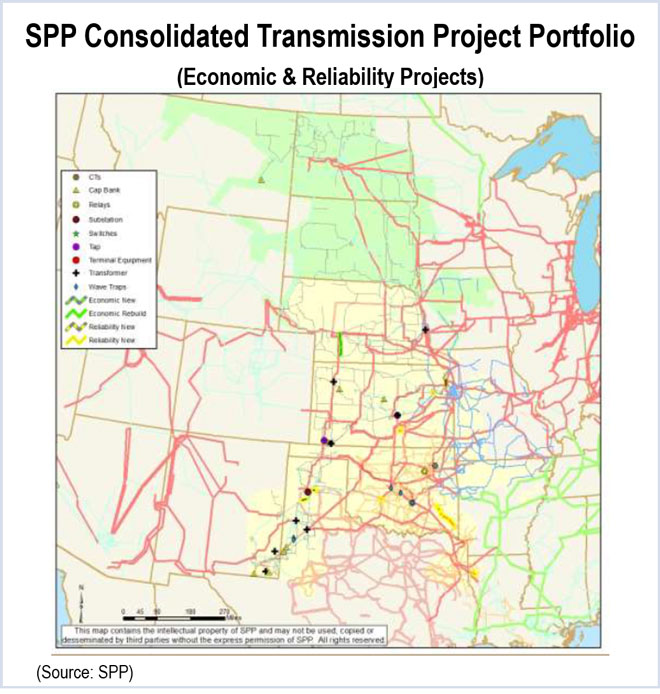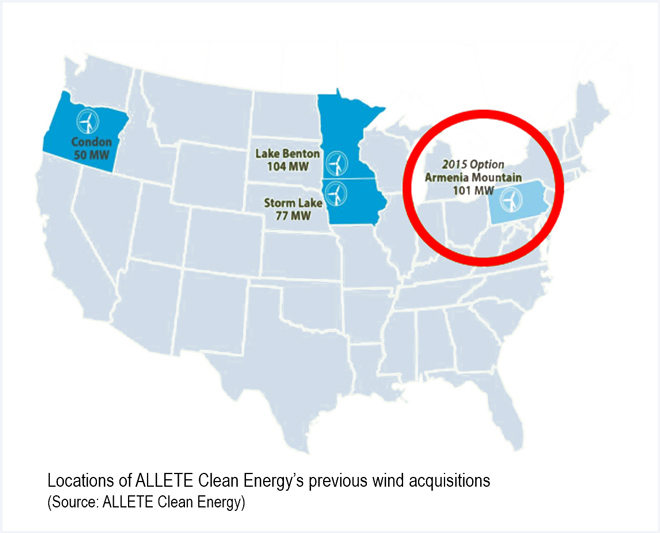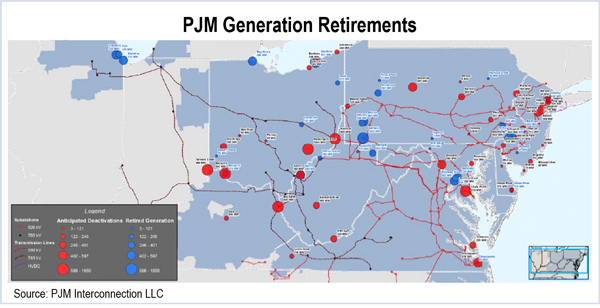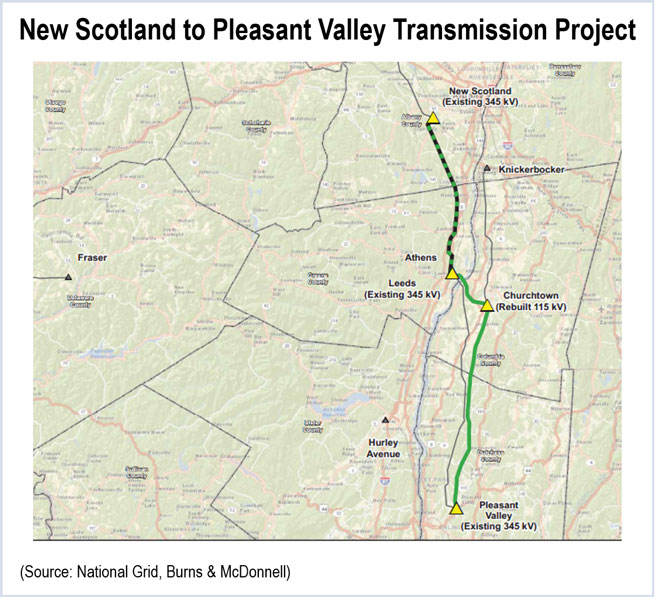By Rich Heidorn Jr.

Several members of the Markets & Operations Policy Committee complained that the spending was benefitting wind exporters rather than internal loads and that the RTO’s load projections — driven in part by oil and gas producers — might prove too high.
Members also rescinded approval for a controversial project in the Ozarks in the face of falling demand projections and split one project in two, agreeing to consider generation alternatives to a local voltage problem.
Doubts about Load Projections
Burton Crawford of Kansas City Power and Light declined to endorse the 2015 Integrated Transmission Plan 10-year (ITP10) assessment, which was approved by voice vote with some nays and multiple abstentions.
Crawford said the assessment predicts wholesale sales 50% higher than his company’s internal estimates. “We’re a little concerned with the calculations behind this,” he said.
“We’re concerned that the load forecast is way off,” said the Empire District Electric Co.’s Bary Warren, who noted that much of the growth is based on anticipated demand from oil and gas producers. With the continued fall in oil prices, he said, “we need to determine if these projects will be needed.”
“What if oil goes to $20 a barrel and everyone stops drilling? Or there’s more earthquakes in North Texas and that affects fracking?” he added. “Things have changed in the last six months.”
But Jay Caspary, SPP director of research, development and special studies, noted that while spot prices have fallen to $45 a barrel, futures prices remain above $80, suggesting the price drop may be short-lived.
Several speakers also noted the volume of existing wind generators and oil producers that are unable to connect to SPP.
Xcel Energy’s Southwestern Power System (SPS) area in North Texas and eastern New Mexico is showing the worst potential problems in SPP’s reliability studies.
“They’re out there pumping oil. So there’s additional load that we could add to our system if we had the infrastructure in place,” Caspary said.
Caspary said there has been no significant drop in activity in the SPS territory, noting that The Wall Street Journal recently reported that rigs are being redeployed from the Eagle Ford shale zone in south Texas to the Permian Basin, an SPS territory in southeast New Mexico.
Bill Grant of Xcel Energy said there is at least 80 MW of load that wants to be served, including 30 MW of requests that were denied service and 53 MW of distributed generation.
Warren said the near-term prospects will become clearer this spring when oil producers announce their capital spending plans.
Cost Allocation, Modeling Complaints
SPP’s cost allocation and modeling methodology also came under criticism.
“We’re getting allocated these reliability benefits [for improvements] nowhere near our system,” Crawford said.
In abstaining on ITP10, Warren cited concern about how benefits are calculated.
“We need to think about whether there are some fundamental problems with the way we model our system,” commented Richard Ross of American Electric Power.
Jason Atwood of Northeast Texas Electric Cooperative voted against the 2015 Integrated Transmission Plan Near-Term assessment (ITPNT), which was endorsed with several abstentions. “I don’t want my load to pay for transmission to move power outside the footprint,” he said.
Atwood said wind generation in SPP has never exceeded 1,000 MW during the summer peak, “and we’re modeling for 7,000” MW based on transmission service reservations.
Discussing SPP’s strategic initiatives later in the meeting, Michael Desselle, SPP vice president of process integrity and chief administrative officer, said the RTO’s highway/byway cost allocation methodology is “not appropriate” for exports.
Jeff Knottek, of City Utilities of Springfield, Mo., raised a more acute modeling issue, citing the occurrence of transmission load relief procedures on two flowgates between SPP and Associated Electric Cooperative.
“No one can seem to replicate this problem that occurs in real time. We need to dig down and find what the cause of the problem is.”
2015 ITP10
The MOPC approved a portfolio of $273 million in engineering and construction costs for projects based on the ITP10 assessment of a business-as-usual future and one that assumed up to 20% of hydro capacity and conventional generation — including most coal units under 200 MW — would be lost.
It included 166 miles of reliability projects estimated at almost $210 million and 94 miles of economic projects costing almost $70 million.
The MOPC’s approval also recommended the Board of Directors issue Notifications to Construct (NTCs) for 16 projects needed in 2019. These projects’ cost of $142 million was reduced when members amended the plan to split the largest project, totaling $36 million, into two.
The original project would add a new substation with a 345/115-kV transformer on the Hitchland-Finney 345-kV line; a new 1-mile, 115-kV line from the substation to the Walkemeyer 115-kV line; and a second 21-mile, 115-kV line from Walkemeyer to North Liberal.
Members voted to split the project in two based on differences in the needed in-service dates. Some members suggested studying whether converting the 76-MW Cimarron natural gas generator to a synchronous condenser would eliminate the need for the Walkemeyer-North Liberal line.
Other projects exceeding $10 million were an upgrade of the Iatan-Stranger Creek 161-kV line to 345 kV ($16.1 million) and the rebuild of the South Shreveport-Wallace Lake 138-kV line ($10.3 million).
2015 ITPNT
The 2015 ITPNT, which addresses reliability problems through 2020, includes 42 projects totaling $257 million. Eight of the projects also were identified in the 10-year plan.
More than half of the total is slated for New Mexico ($82.1 million) and Kansas ($50.7 million).
The MOPC separately endorsed two Consolidated Balancing Area projects in the 2015 ITPNT: an upgrade of 138-kV terminal equipment at Benton ($480,000) and a rebuild of the Southwestern Station-Carnegie 138-kV line ($13.4 million).
Ozarks Project Cancelled
Members also recommended the Board of Directors withdraw the NTC for the 41-mile Kings River-Shipe Road 345-kV line.
The NTC was issued following the 2007 Ozark Study as one of several 345-kV projects that would create a loop around Northwest Arkansas and extend eastward across northern Arkansas and into southern Missouri.
Southwestern Electric Power Co. opposed the route selected and requested rehearing. The project also was opposed by a citizens group, Save the Ozarks.
Lanny Nickell, SPP vice president of engineering, said a review last year showed a 50% drop in load growth rates in the area critical to the project’s need. There was a 54-MW drop in post-contingency loading on the East Rogers-Avoca 161-kV line, “a fairly large percentage of [the new line’s] capability,” Nickell said.
“We’re not seeing nearly the severity in the number of overloads that we saw the last time,” he said.






